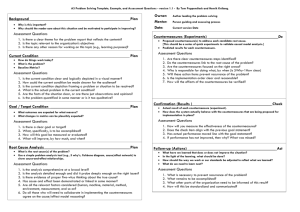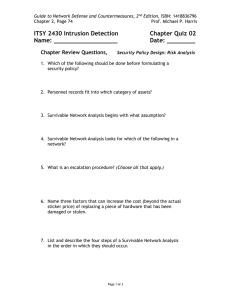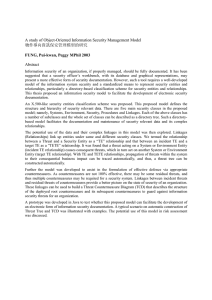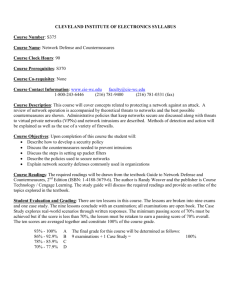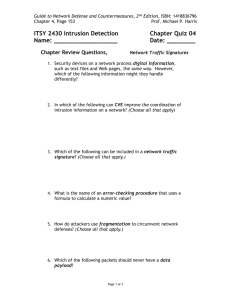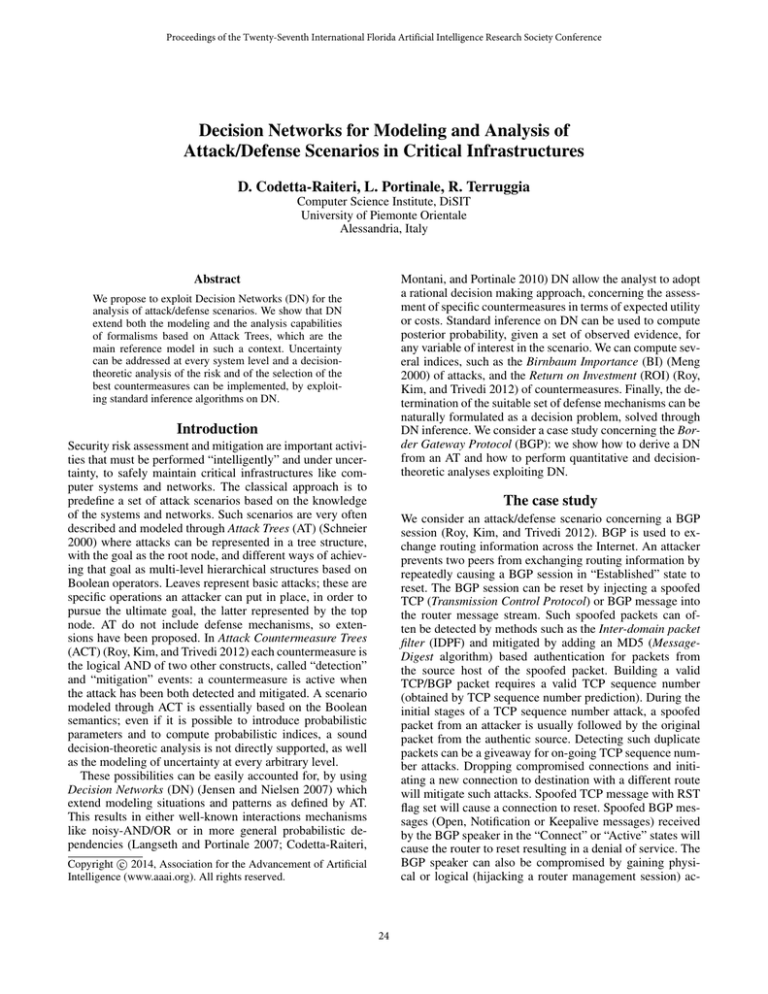
Proceedings of the Twenty-Seventh International Florida Artificial Intelligence Research Society Conference
Decision Networks for Modeling and Analysis of
Attack/Defense Scenarios in Critical Infrastructures
D. Codetta-Raiteri, L. Portinale, R. Terruggia
Computer Science Institute, DiSIT
University of Piemonte Orientale
Alessandria, Italy
Abstract
Montani, and Portinale 2010) DN allow the analyst to adopt
a rational decision making approach, concerning the assessment of specific countermeasures in terms of expected utility
or costs. Standard inference on DN can be used to compute
posterior probability, given a set of observed evidence, for
any variable of interest in the scenario. We can compute several indices, such as the Birnbaum Importance (BI) (Meng
2000) of attacks, and the Return on Investment (ROI) (Roy,
Kim, and Trivedi 2012) of countermeasures. Finally, the determination of the suitable set of defense mechanisms can be
naturally formulated as a decision problem, solved through
DN inference. We consider a case study concerning the Border Gateway Protocol (BGP): we show how to derive a DN
from an AT and how to perform quantitative and decisiontheoretic analyses exploiting DN.
We propose to exploit Decision Networks (DN) for the
analysis of attack/defense scenarios. We show that DN
extend both the modeling and the analysis capabilities
of formalisms based on Attack Trees, which are the
main reference model in such a context. Uncertainty
can be addressed at every system level and a decisiontheoretic analysis of the risk and of the selection of the
best countermeasures can be implemented, by exploiting standard inference algorithms on DN.
Introduction
Security risk assessment and mitigation are important activities that must be performed “intelligently” and under uncertainty, to safely maintain critical infrastructures like computer systems and networks. The classical approach is to
predefine a set of attack scenarios based on the knowledge
of the systems and networks. Such scenarios are very often
described and modeled through Attack Trees (AT) (Schneier
2000) where attacks can be represented in a tree structure,
with the goal as the root node, and different ways of achieving that goal as multi-level hierarchical structures based on
Boolean operators. Leaves represent basic attacks; these are
specific operations an attacker can put in place, in order to
pursue the ultimate goal, the latter represented by the top
node. AT do not include defense mechanisms, so extensions have been proposed. In Attack Countermeasure Trees
(ACT) (Roy, Kim, and Trivedi 2012) each countermeasure is
the logical AND of two other constructs, called “detection”
and “mitigation” events: a countermeasure is active when
the attack has been both detected and mitigated. A scenario
modeled through ACT is essentially based on the Boolean
semantics; even if it is possible to introduce probabilistic
parameters and to compute probabilistic indices, a sound
decision-theoretic analysis is not directly supported, as well
as the modeling of uncertainty at every arbitrary level.
These possibilities can be easily accounted for, by using
Decision Networks (DN) (Jensen and Nielsen 2007) which
extend modeling situations and patterns as defined by AT.
This results in either well-known interactions mechanisms
like noisy-AND/OR or in more general probabilistic dependencies (Langseth and Portinale 2007; Codetta-Raiteri,
The case study
We consider an attack/defense scenario concerning a BGP
session (Roy, Kim, and Trivedi 2012). BGP is used to exchange routing information across the Internet. An attacker
prevents two peers from exchanging routing information by
repeatedly causing a BGP session in “Established” state to
reset. The BGP session can be reset by injecting a spoofed
TCP (Transmission Control Protocol) or BGP message into
the router message stream. Such spoofed packets can often be detected by methods such as the Inter-domain packet
filter (IDPF) and mitigated by adding an MD5 (MessageDigest algorithm) based authentication for packets from
the source host of the spoofed packet. Building a valid
TCP/BGP packet requires a valid TCP sequence number
(obtained by TCP sequence number prediction). During the
initial stages of a TCP sequence number attack, a spoofed
packet from an attacker is usually followed by the original
packet from the authentic source. Detecting such duplicate
packets can be a giveaway for on-going TCP sequence number attacks. Dropping compromised connections and initiating a new connection to destination with a different route
will mitigate such attacks. Spoofed TCP message with RST
flag set will cause a connection to reset. Spoofed BGP messages (Open, Notification or Keepalive messages) received
by the BGP speaker in the “Connect” or “Active” states will
cause the router to reset resulting in a denial of service. The
BGP speaker can also be compromised by gaining physical or logical (hijacking a router management session) ac-
c 2014, Association for the Advancement of Artificial
Copyright Intelligence (www.aaai.org). All rights reserved.
24
Figure 1: ACT for BGP attack/defense scenario (Roy, Kim, and Trivedi 2012)
tion of XE according to g;
- for each attack event A output of a gate G (Boolean function g) with input attack events A1 , . . . Ak and input countermeasure CM = hD, M i (with probability of detection pD
and probability of mitigation pM ), create a binary chance
node XE , set XA1 . . . XAk , XCM as parent of XE and set
the CPT for XE = true in the following way: entries corresponding to XCM = inactive are set according to the truth
value of g(XA1 , . . . XAk ) i.e. either 1 when true or 0 when
false; entries corresponding to XCM = active are set as
g(XA1 , . . . XAk ) (1 − pD pM ).
DN model. The DN corresponding to the ACT is reported
in Fig. 2. We used G ENIE (http://genie.sis.pitt.edu) to build
the model and to perform every computation that is reported hereinafter; probabilities of attacks are annotated near
chance nodes representing basic attacks, while probabilities
of success of countermeasures are near decision nodes. Deterministic variable nodes have the corresponding Boolean
function reported by the node itself.
Example. Tab. 1.a reports the CPT for node TSNAS given
the parents TSNA and DDRR. Given that countermeasure
DDRR is composed by the detection event Detect Duplicate Packets and by the mitigation event TCP reset and
different route to destination (Fig. 1), with probability of
detection pD = 0.8 and probability of mitigation pM =
0.5 respectively, the probability of countermeasure success is pDDRR = 0.8 · 0.5 = 0.4; thus, when the attack occurs (TSNA=true), if the countermeasure is activated
(DDRR=active) there is a 60% chance of having the attack
unmitigated and successful (CPT in Tab. 1.a).
cess to the router. Usually router hijacking is characterized
by anomalous packet forwarding which can be detected by
traffic monitoring at the router and mitigated by securing or
replacing the router.
From ACT to DN
The ACT of Fig. 1 formalizes such a scenario and is completed by: the probability of occurrence of each atomic attack (attack leaf node), the probability of a successful detection (detection nodes), the probability of a successful mitigation (mitigation nodes), the security investment cost of
countermeasures (both detections and mitigations), the impact or cost of each atomic attack. The ACT and all its parameters are taken from (Roy, Kim, and Trivedi 2012).
DN generation. We define the following rules to construct
a DN from an ACT:
- for each atomic attack node Ai with probability pAi , create a binary chance node XAi (graphically represented as
oval) with values true (occurrence of attack) and false; set
the Conditional Probability Table (CPT) of XAi such that
P [XAi = true] = pAi ;
- for each countermeasure (i.e. a pair CM = hD, M i with
D detection event and M mitigation event), create a binary
decision node XCM (rectangle) with values active (attack
detected and mitigated) and inactive;
- for each attack event A output of a gate G (representing the Boolean function g) with inputs A1 , . . . Ak , create
a binary deterministic node XE (double-boarded oval), set
XA1 . . . XAk as parent of XE and set the deterministic func-
25
Figure 2: DN for the BGP scenario
IDM D5 = active and the other countermeasures set to
inactive), by performing the query P [Goal|IDM D5 =
active, DDRR = inactive, F SR = inactive] = 0.418,
resulting in more than 40% probability of being vulnerable to the attack. We notice that, given that countermeasure are not 100% effective, the attacker can reach the goal
(with about 27% of probability) even in presence of all
countermeasures: P [Goal|IDM D5 = active, DDRR =
active, F SR = active] = 0.274
Importance. Such quantities can be defined in different
ways and are usually identified with the aim of prioritizing
defense mechanisms (i.e. countermeasures) to counteract attack events. An importance measure that can be adapted
from reliability theory is the Birnbaum Importance (BI)
(Meng 2000) which measures the change in the probability
of the attacker’s goal caused by a change in the probability
of the attack of interest: BI(Ai ) = P [Goal = true|Ai =
true] − P [Goal = true|Ai = f alse].
Example. Fig. 3.a shows BI under different sets of countermeasures. BI points out that compromising the router (attack
CR) is the most important attack. This is due to the fact that
unmitigating the attack will definitely cause the occurrence
of the goal; moreover, BI puts in evidence that such an attack
is more important in case it is not defended by the suitable
countermeasure.
Risk. This corresponds to compute the expected impact of a
particular attack/defense scenario. Since the impact IGoal is
measured as the amount of damage provided by the success
of the attacker’s goal, the risk is defined as R = pGoal IGoal
being pGoal the probability of success of the goal (Roy, Kim,
and Trivedi 2012). R is computed relatively to a particular
context, usually a specific set of active countermeasures. In
the DN framework, R can be computed by adding a value
node (Impact in Fig. 2) to the goal node and setting the active
and inactive countermeasures as evidence to decision nodes.
The value function on the Impact node can be determined either by a direct estimation of the damage of a successful attack (occurrence of the goal) or by exploiting some heuristic
approach synthesizing the impact on the goal, starting from
Table 1: a) Modeling countermeasure success b) Adding uncertainty to GOAL in BGP scenario
a)
TSNA
true
DDRR
inactive active
TSNAS=true
1
0.6
TSNAS=false
0
0.4
RRS
true
true
false
b) CRS
GOAL=true
1
0.9802
0
0.0198
GOAL=false
false
inactive active
0
0
1
1
false
true false
1
0.01
0
0.99
Noisy gates. The structure created with this method represents a main skeleton over which more features can be added
or modified. For example, in case of “noisy gates” (which
are not representable in the ACT), we can adapt the corresponding CPT to account for this additional uncertainty.
Example. Consider the case where there is a 2% probability
that a spoofed malicious message does not reach the router;
in addition, suppose we want to model additional uncertainty, by introducing also a small chance (e.g. 1% probability) of the router being reset for some unmodeled causes. In
such a case the type of node ResetBGP can be changed from
deterministic to a noisy-OR chance node with leak (Jensen
and Nielsen 2007); the noisy-OR parameters are then
p1 =P[Goal=true—RRS=true, CRS=false]=0.98
p2 =P[Goal=true—CRS=true, RRS=false]=1
pleak =P[Goal=true—RRS=false,CRS=false]=0.01
resulting in the CPT of Tab. 1.b.
Quantitative Analysis
Probability of attacker’s goal. This is the probability that
an attacker will actually pursue the goal, given some initial specification in terms of probability of basic attacks and
presence of countermeasures.
Example. We compute the probability of a successful attack given that we implemented only the IDPF detection with MD5 authentication (i.e. evidence inserted as
26
Example. Considering a cost of 40, 30 and 50 for activating countermeasures IDMD5, DDRR and FSR respectively,
Tab. 2 reports the results of the computation of the best set
of countermeasures to activate, depending on observations
concerning nodes CR, TSNA and TCSR. We notice that having countermeasure FSR inactive is a good option (the best
one), only when we are sure that CR attack has not occurred.
ROI. An interesting aspect related to the selection of the
best countermeasures concerns the so called Return on Investment (ROI) index (Roy, Kim, and Trivedi 2012). It represents the percentage of investment gain w.r.t. the investment cost. It is defined by comparing a status-quo situation
(a set of countermeasures CMi−1 ) and a target one (another set CMi ), differing from the status-quo in terms of
a set of investments. By denoting with Ri the risk associated
with CMi and by Ci the cost of implementing CMi from
CMi−1 , then the ROI index is defined as:
i −Ci
ROI(i) = Ri−1 −R
Ci
Example. Consider the situation CM0 (no active countermeasure) corresponding to a risk (expected impact) of
106554; in case we do not have any evidence about attacks,
solving the DN suggests that the best (in terms of risk) decision is CM1 (all the countermeasures are activated) corresponding to a risk of 68395. Since implementing CM1
has an investment cost C1 = 120 we compute the ROI as
R0 −R1 −C1
= 106554−68395−120
= 316.99, meaning that
C1
120
for each unit of investment, we get back about 317 units.
Figure 3: a) BI measure of basic attacks b) Risk evaluation
w.r.t. probability of CR attack
Table 2: Best set of countermeasures
Obs. Att.
None
CR=false
CR=true
TSNA=true
TSNA=false
TCSR=true
TCSR=false
IDMD5
DDRR
FSR
Tot. Exp. Cost
68515
4658
164225
99072
65050
72890
68135
Conclusions
We have proposed DN as a reference model for the analysis
of attack/defense scenarios. The advantages can be considered from both the modeling and the analysis point of view:
uncertainty at every level of the scenario can be captured,
probabilistic indices can be computed through standard inference, and a decision theoretic approach can be exploited
to select the best set of countermeasures to activate. This has
been shown through a case study concerning BGP.
local impact estimation of each basic attack’s impact (Roy,
Kim, and Trivedi 2012). Since the goal’s impact represents
a damage (i.e. a cost), a negative utility can be used in the
corresponding value node.
Example. Assuming IGoal = 250000, Fig. 3.b reports the
risk value (expected impact) with respect to different sets of
active countermeasures, by varying the probability of CR attack (the most important one as noticed before). We confirm
also from risk evaluation that activating countermeasures not
related to a router hijacking attack is not useful at reducing
the global risk, while the presence of an active firewall and
an alternative routing strategy can provide a risk reduction.
Investment. When measuring the impact deriving from a set
of countermeasures, the investment cost in setting up such
defense mechanisms should be taken into account as well.
To this aim, value nodes IC1, IC2, IC3 (with negative utility
values) are added in the DN to decision nodes. The total expected cost can be computed by considering a cost function
which is the sum of the cost nodes and the impact node. This
can be useful to evaluate the best set of countermeasures to
activate given a set of observed attacks.
References
Codetta-Raiteri, D.; Montani, S.; and Portinale, L. 2010.
Supporting reliability engineers in exploiting the power of
dynamic bayesian networks. International Journal of Approximate Reasoning 51(2):179–195.
Jensen, F., and Nielsen, T. 2007. Bayesian Networks and
Decision Graphs (2nd ed.). Springer.
Langseth, H., and Portinale, L. 2007. Bayesian networks
in reliability. Reliability Engineering and System Safety
92(1):92–108.
Meng, F. 2000. Relationships of Fussell–Vesely and Birnbaum importance to structural importance in coherent systems. Reliability Engineering and System Safety 67:55–60.
Roy, A.; Kim, D.; and Trivedi, K. 2012. Scalable optimal
countermeasure selection using implicit enumeration on attack countermeasure trees. In International Conference on
Dependable Systems and Networks.
Schneier, B. 2000. Secrets and Lies: digital security in a
networked world. J. Wiley.
27


